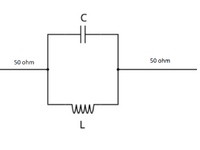kobi731
Newbie

Hello,
I have a very simple question that I haven't found an answer to it anywhere online.
If I want to design a wideband filter—or any other circuit— that it have parallel components (like in the image below) as a electrical schematic. And I'm using lumped elements, how should I implement it in the layout for achieve good and wideband performance.
I.E like using ADS?
What I'm currently doing isn’t working at all.
maybe use Wilkinson divider but it make it too complicated.
I have a very simple question that I haven't found an answer to it anywhere online.
If I want to design a wideband filter—or any other circuit— that it have parallel components (like in the image below) as a electrical schematic. And I'm using lumped elements, how should I implement it in the layout for achieve good and wideband performance.
I.E like using ADS?
What I'm currently doing isn’t working at all.
maybe use Wilkinson divider but it make it too complicated.
Attachments
Last edited:

